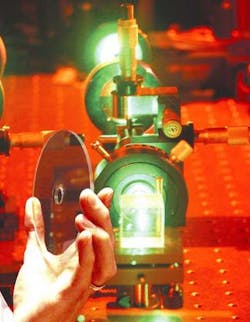A holographic disk, written to and read by low-power lasers at Gbit/s rates, stores hundreds of gigabytes and can be searched at rates of 32 Gbyte/s.
null
Although the difference in storage capacity between the digital versatile disk (DVD) and the compact disk (CD) is large enough to push DVD technology into the consumer world (thus rendering millions of personal computers obsolete), this difference is less than an order of magnitude. In fact, the DVD is only an improved version of the CD. While the DVD can be further refined, a radical increase in storage densities requires a different approach. Engineers at Aprilis (Maynard, MA) have developed a CD-sized holographic storage disk that holds on the order of a terabit of information—a factor of a thousand more than a CD (see figure). And, unlike CDs and DVDs, the Aprilis disk is quickly searchable—a property that springs naturally from the holographic reading process.
The medium itself is an outgrowth of a holographic material developed in the mid-1990s at Polaroid (Cambridge, MA). Not long after the material was developed, a three-year investigation by the Photorefractive Information Storage Materials (PRISM) consortium—a group of nine companies and one university, sponsored by the Defense Advanced Research Projects Agency (DARPA)—found the Polaroid version to be the only one of 57 candidate storage materials to meet specifications for a rotating disk digital holographic storage system. Aprilis was formed to fully exploit this material.
According to John Berg, chief executive officer of Aprilis, and David Waldman, the company's vice president of research and development, the material's secret lies partially in its low shrinkage upon curing (developing). As the Aprilis medium cures, chemical rings in the material open; this polymerization reduces shrinkage, explains Waldman. In addition, notes Berg, although holographic materials must be preconditioned, or partially cured, the Aprilis medium needs less preconditioning, making it more reactive to light. Such sensitivity allows low-power lasers to be used for recording. Data densities of greater than 100 Gbit/in2 have been achieved—a world record for recording in polymer, claims Berg.
The read-write optical system is small, with apertures no greater than 10 mm. A spatial light modulator containing about 106 pixels forms pages of information that are recorded onto the disk as units. Information is read from the disk by a 0.5-mm spot of light. Although the existing light source for recording is a 532-nm-emitting frequency-doubled Nd:YAG laser, systems incorporating blue laser diodes are the next step, says Waldman. Recording and reading rates reach 1 Gbit/s.
One feature of the Aprilis holographic system that cannot be duplicated in CDs and DVD systems (or any serially read system, for that matter) is its fast-search capability. As described by Waldman, a search for a certain string of data is carried out locally by encoding the read beam. The analog strength of the return signal is in direct proportion to the strength of the match between the encoded read beam and the data on the disk; a simple increase in a photosensor reading signals a match. This is in contrast to an ordinary storage system, which must include its central processing unit in the search for a string of data.
The local nature of the holographic search results in search speeds of up to 32 Gbyte/s (although retrieval speed is currently limited to approximately 1-Gbit/s). A comparison of the Aprilis drive to an ordinary hard drive, performed by IBM (Armonk, NY), found that the equivalent of a half-hour search on the hard drive took a few milliseconds on the holographic disk, says Berg. "For business use, this could be the 'killer app,' " he notes.
Fifteen customers are currently evaluating the Aprilis medium, according to Berg. "They include the largest South Korean and Japanese electronics manufacturers, with Sony being just one example," he says. The approaches of these companies vary: some want only the medium and are developing their own hardware, while others desire a complete system. Some are developing products, while others use the Aprilis systems as low-cost players. After an initial effort to seed the market, Berg sees first an Aprilis product (a drive) being targeted to businesses, then an eventual move into the consumer world.
